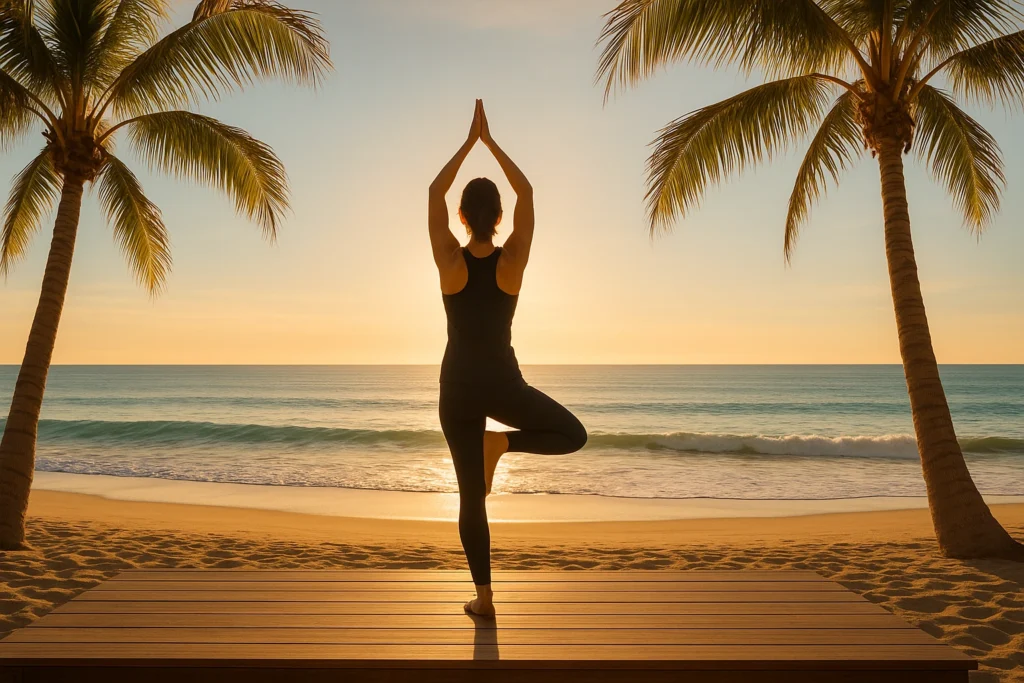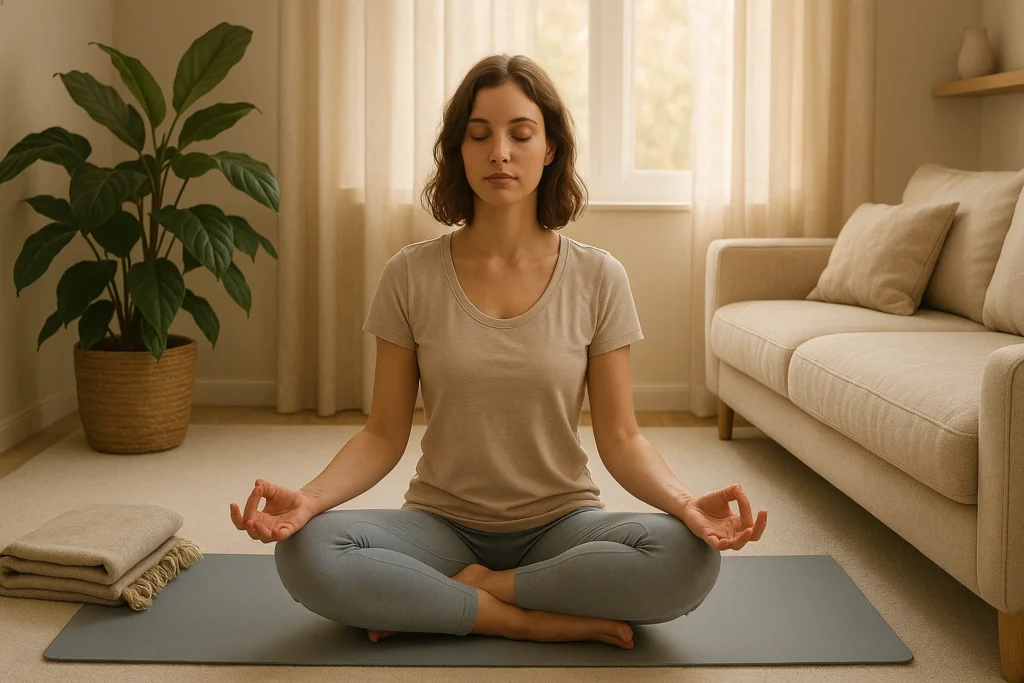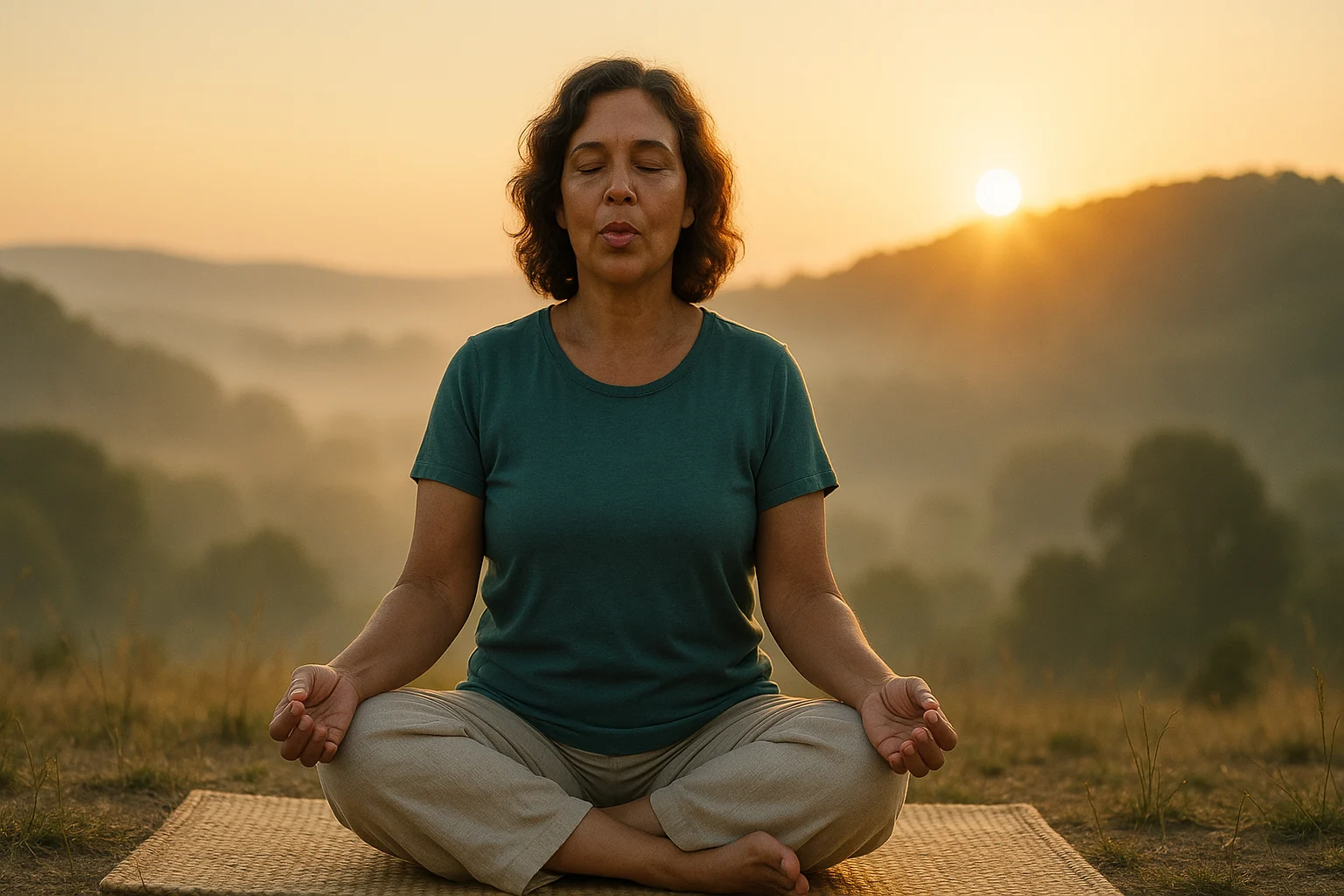
Hot flashes keeping you up? Ayurveda menopause care, paired with yoga, may help cool your body, steady your mood, and support sleep. Menopause can bring hot flashes, mood swings, and restless nights—yet there’s a gentler path. For a step-by-step plan, start with our yoga specialized health guide.
Find Your Menopause Relief Plan!Table of Contents
- Key Takeaways: Menopause Support With Ayurveda & Yoga
- Understand Your Dosha (Ayurvedic Approach)
- How Yoga & Ayurveda Work Together
- Gentle Yoga for Menopause Relief
- Ayurvedic Lifestyle Tips to Enhance Yoga
- Real Stories: Women Thriving with Ayurveda for Menopause
- Menopause Wellness Quiz
- Frequently Asked Questions
- Conclusion: Embrace Your Menopause Journey
Key Takeaways: Ayurveda Menopause Relief
- Holistic Relief: Ayurvedic menopause relief plus yoga may help you balance your body and settle your mind.
- Dosha-specific: Match poses, breath, and daily habits to your Vata, Pitta, or Kapha so the plan fits you.
- Yoga may help: Try Child’s Pose and the cooling Sitali breath to help cool hot flashes, take the edge off anxiety, and support better sleep.
- Works with your life: An Ayurvedic menu, steady routines, and stress tools may help yoga’s benefits go further.
- Empowerment: With steady practice, you may feel more in control and supported in your vitality.
Ayurveda Menopause Management: Understanding Your Dosha
Ayurveda, the ancient Indian system of medicine, sees health as a balance of three energies or doshas: Vata, Pitta, and Kapha. These doshas, made of the five elements (ether, air, fire, water, earth), govern your body and mind. When balanced, you feel vibrant; when imbalanced, symptoms like those of menopause arise.
In Ayurvedic tradition, menopause is considered a Vata-dominant phase, as this dosha’s dry, light, and mobile qualities increase with age. However, hormonal shifts can also trigger Pitta (heat, intensity) or Kapha (heaviness, stagnation). Thus, understanding your dosha, perhaps through our Ayurveda doshas quiz, is the first step to personalized relief.
Vata Imbalance: Dryness and Restlessness
Vata, linked to air and ether, feels like a dry, windy day in your body. Symptoms include dry skin, irregular periods, anxiety, insomnia, joint pain, and feeling ungrounded. For example, Sarah, a 52-year-old, noticed anxiety and sleeplessness worsening as menopause began, signaling a Vata imbalance.
Pitta Imbalance: Heat and Irritability
Pitta, tied to fire and water, can act like an overactive campfire—bright and quick to flare. When Pitta runs high, you might notice more hot flashes, night sweats, irritability, or skin flare-ups. Sarah described waves of heat that derailed her day, a classic Pitta pattern, and she felt understandably frustrated.
Kapha Imbalance: Sluggishness and Weight Gain
Kapha, rooted in earth and water, can feel like a damp, heavy fog. While less common at midlife, you may notice slower mornings, weight creeping up, brain fog, or a heavier mood. Knowing your dominant dosha helps you tailor Ayurvedic menopause care to what you actually feel.
This post has affiliate links. We may earn a commission. Learn more.
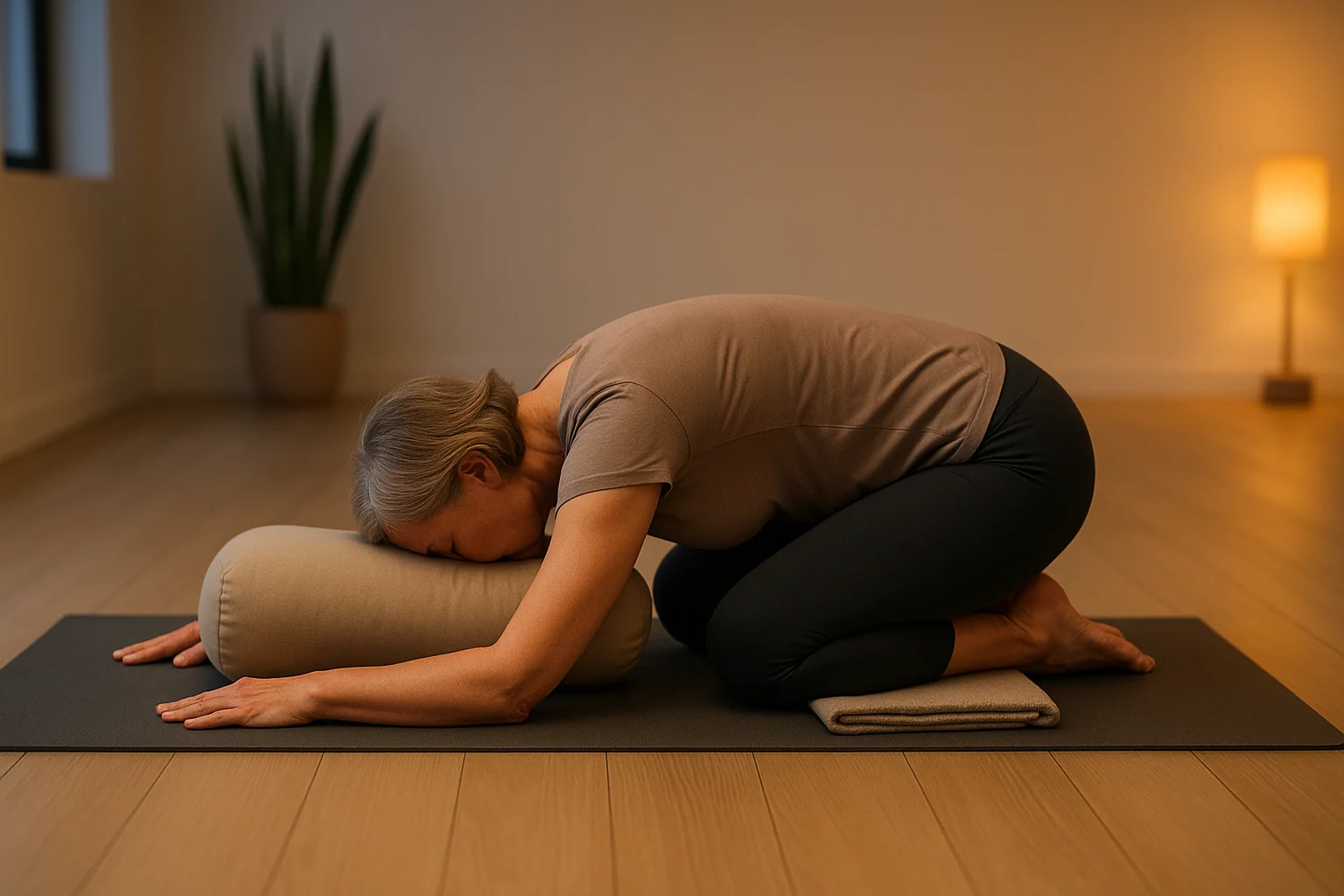
The Synergy of Yoga and Ayurveda for Menopause
Yoga and Ayurveda belong together: Ayurveda shows what’s off; yoga offers the tools—movement, breath, and rest—to steady it. Used together, they offer a supportive way to help you navigate menopause at your own pace. Even 10–15 minutes of a short, hormone-supporting flow may help you feel more grounded day to day. We break it down in our yoga for stress relief guide.
Evidence snapshot: A large randomized trial found yoga did not reduce hot-flash frequency or bother but did improve insomnia symptoms. Source.
- Calms your system: Gentle movement may help lower stress and soften anxiety.
- Backs hormonal changes: Regular practice may help your body adapt.
- Encourages circulation: Gentle poses and breathwork may support healthy circulation.
- Personal to you: Dosha guidance keeps the plan targeted.
- Fits your day: Food and routines support what you do on the mat.
“Yoga is the dance of every cell with the music of every breath, creating inner serenity.” — Debasish Mridha
Menopause Yoga Poses for Symptom Relief
Want support in a short window? Spend 10–15 minutes with these menopause yoga poses, matched to your dosha. Start small, notice what helps, and keep what feels good.
General Practices for All Doshas
New to this? Begin here. These moves are easy on the body, settle a busy mind, and get blood flowing.
- Gentle Warm-ups: Rotate ankles, wrists, hips, and shoulders slowly.
- Child’s Pose (Balasana): Kneel, sink your hips toward your heels, reach your arms forward, and rest your forehead on the mat. Stay for several slow breaths.
- Diaphragmatic Breathing: Lie down, place one hand on your chest and one on your belly, and breathe so your belly rises and falls more than your chest.
Vata-Balancing Yoga Poses
When Vata shows up as dryness or worry, choose grounding, gently warming poses. Move a little slower than usual and let each action feel deliberate.
- Mountain Pose (Tadasana): Stand tall with feet about hip-width. Soften your knees and feel the floor under your feet as you lengthen through the crown.
- Tree Pose (Vrksasana): Balance on one leg, placing the other foot on your inner thigh, to foster focus.
- Warrior II (Virabhadrasana II): A strong pose that builds confidence.
- Legs-Up-the-Wall (Viparita Karani): Lie with legs up a wall for 5-15 minutes; this may help you feel calmer and support sleep.
- Nadi Shodhana (Alternate Nostril Breathing): Alternate breathing through each nostril for 5-10 rounds to balance the mind.
Pitta-Cooling Practices for Hot Flashes
Pitta’s heat can contribute to hot flashes and irritability. Cooling poses and breathwork may help you feel cooler and less reactive.
- Supine Bound Angle Pose (Supta Baddha Konasana): Lie back with soles together, knees open, supported by blankets.
- Seated Forward Fold (Paschimottanasana): Sit, extend legs, fold forward, keeping your spine long.
- Supported Bridge Pose (Setu Bandhasana): Lie with a block under your sacrum for a gentle inversion.
- Sitali Breath: Inhale through a curled tongue (or pursed lips if curling isn’t accessible), then exhale softly through the nose. Try 5–10 rounds and notice if you feel a touch cooler.
Kapha-Energizing Practices
When Kapha feels heavy or sluggish, choose steady, rhythmic movement that builds warmth without tipping into overheating.
- Gentle Sun Salutations: Move through a few easy rounds to gradually build warmth and momentum.
- Warrior I & II: Plant your feet, reach actively through your arms, and feel the lift in your chest.
- Chair Pose (Utkatasana): Build heat and strength.
- Kapalabhati Breath: Rapid exhales that some people find help with mental clarity (consult a teacher first).
Restorative Yoga for All
Restorative poses, held for 5-20 minutes with props, can promote deep relaxation.
- Savasana: Lie flat, arms and legs spread, and surrender tension.
- Supported Child’s Pose: Rest over a bolster for comfort.
Yoga for Hormonal Balance: Simple Daily Flow
To feel steadier during perimenopause and menopause, try 10–15 minutes of yoga for hormonal balance: a few gentle backbends (like low Cobra), a supported inversion (Supported Bridge), and 3–5 minutes of paced breathing (inhale 4, exhale 6). Keep it calm, not strenuous.
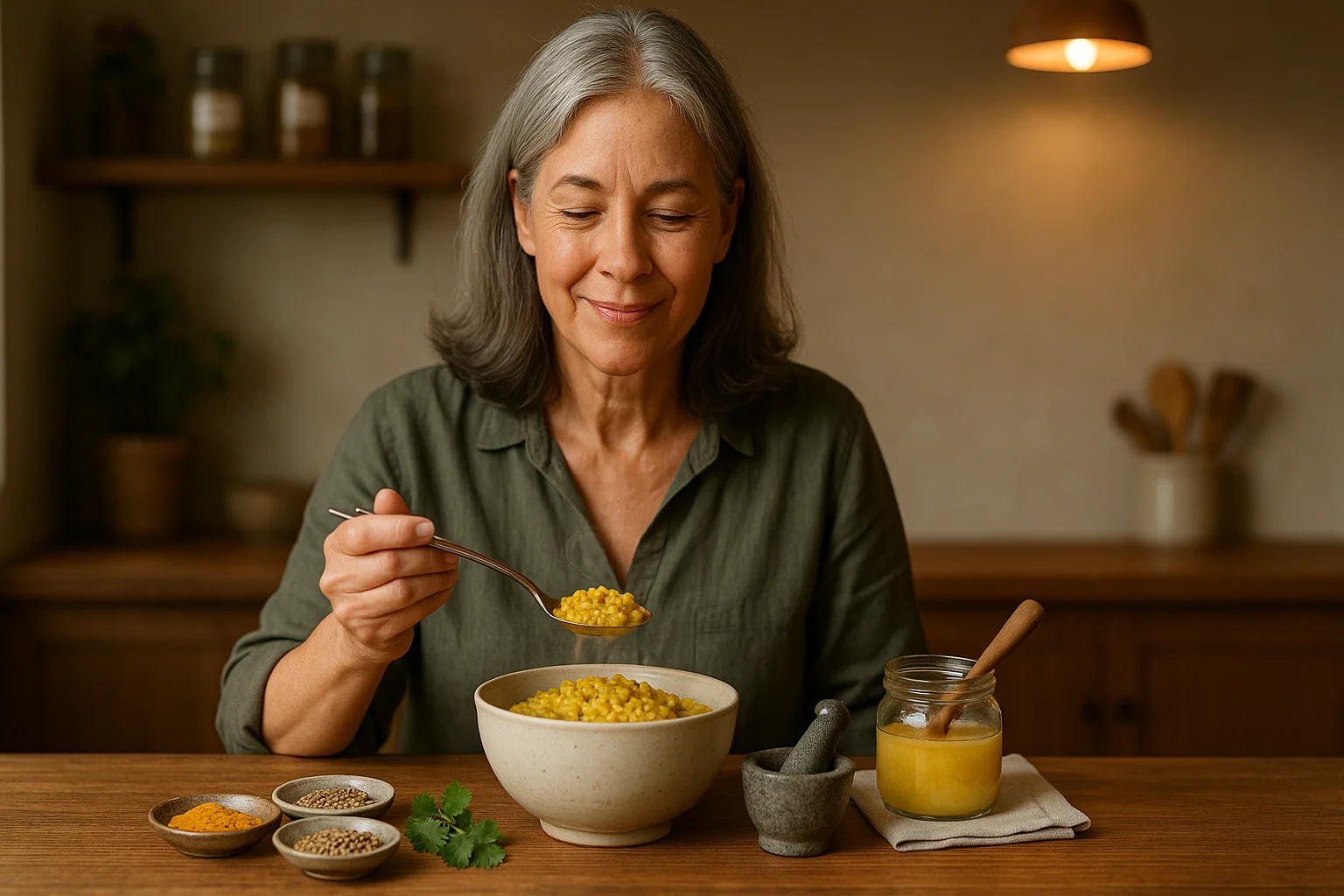
Ayurvedic Lifestyle Tips to Enhance Yoga
Yoga shines brighter with Ayurvedic lifestyle changes. These adjustments may help create a supportive environment for your body and can support Ayurvedic menopause relief. For a deeper dive, explore our guide on Ayurvedic diet basics.
| Dosha | Diet | Routine | Tips |
|---|---|---|---|
| Vata | Warm soups, root vegetables, ghee, warming spices. | Wake before 6 AM, consistent sleep schedule. | Daily sesame oil massage (Abhyanga). |
| Pitta | Cucumber, coconut, leafy greens, cooling spices. | Eat main meal at lunch, avoid late nights. | Use coconut oil for massage. |
| Kapha | Light vegetables, legumes, ginger, black pepper. | Early rising, active mornings. | Limit heavy, oily foods. |
You may also hear about ashwagandha (traditionally used for stress and sleep) and shatavari (traditionally used for dryness and hormonal support). Talk with a qualified practitioner about whether they’re right for you. Herbs can interact with medications—check with your clinician if you take prescription drugs or have a medical condition. Simple adds—like a short meditation or a daily walk—pair well with yoga and can sit alongside medical options such as HRT when needed. Prefer hands-on guidance? Consider an Ayurvedic yoga retreat.
Real Stories: Women Thriving with Ayurveda for Menopause
These practices have helped some women feel more in control during menopause.
Elena’s Hot Flash Relief
Elena, 55, couldn’t sleep through hot flashes. A Pitta-cooling routine (Sitali breath, Supine Bound Angle) plus a cooler diet eased things a lot over three months. “I found the off switch for my internal furnace,” she says.
Maria’s Path to Calm
Maria, 49, felt wired and foggy—classic Vata. Legs-Up-the-Wall and a simple nightly oil massage helped her settle. “It’s like I can breathe again,” she says.
Menopause Wellness Quiz
Find your personalized menopause relief plan with this quick quiz. Answer three questions to discover your dominant dosha and tailored yoga practices.
Which menopause symptom bothers you most?
How does your energy feel during the day?
What’s your skin or body like lately?
Frequently Asked Questions
Conclusion: Embrace Your Menopause Journey
Menopause can feel uncertain, but Ayurvedic menopause care plus yoga can offer practical steps. Try one pose today, one breathing drill tonight, and build from there.
